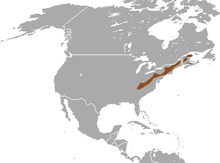Long-tailed shrew
| Long-tailed shrew[1] | |
|---|---|
| Conservation status | |
| Scientific classification | |
| Kingdom: | Animalia |
| Phylum: | Chordata |
| Class: | Mammalia |
| Order: | Soricomorpha |
| Family: | Soricidae |
| Genus: | Sorex |
| Species: | S. dispar |
| Binomial name | |
| Sorex dispar Batchelder, 1911 | |
 | |
| Long-tailed shrew range | |
| Synonyms | |
|
Sorex gaspensis (Anthony & Goodwin, 1924) | |
The long-tailed shrew or rock shrew (Sorex dispar) is a small North American shrew found in Atlantic Canada and the north-eastern United States.
This shrew is slate grey in colour with a pointed snout, a long tail and lighter underparts. It is found on rocky slopes in mountainous areas along the Atlantic coast from Gaspé Peninsula, Quebec and Cape Breton Island, Nova Scotia to northern Georgia. It eats insects and spiders. Predators include hawks, owls, and snakes.
Gaspé shrew
The northernmost examples of this species were until recently thought to be a separate species, the Gaspé shrew (S. gaspensis) inhabiting the Gaspé Peninsula and Cape Breton Island. However, a 2004 study[3] indicated that the two species were conspecific, with the long-tailed shrew exhibiting a cline towards a smaller size at the northern edge of its range. As the Gaspé shrew, it was first described in A new species of shrew from the Gaspé Peninsula in no. 109, 1924 of American Museum Novitates, a publication of the American Museum of Natural History. When they were regarded as separate species, it was recognized that the Gapsé and long-tailed shrews inhabited similar habitats but were thought to be sympatric species with adjacent ranges.[4] They are now generally accepted to be the same species, with gaspensis a junior synonym and not even a subspecies.
Range
The long tailed shrew has an unusually small range. It is found in central New York (the Adirondacks and Catskills) and a small area in Pennsylvania. In Massachusetts, the long-tailed shrew is only found in Berkshire County.
References
| Wikispecies has information related to: Sorex dispar |
- ↑ Hutterer, R. (2005). Wilson, D. E.; Reeder, D. M, eds. Mammal Species of the World (3rd ed.). Johns Hopkins University Press. p. 287. ISBN 978-0-8018-8221-0. OCLC 62265494.
- ↑ Whittaker, J.C., Hammerson, G., Master, L. & Norris, S.J. (2008). "Sorex dispar". IUCN Red List of Threatened Species. Version 2011.2. International Union for Conservation of Nature. Retrieved 18 February 2012.
- ↑ Rhymer, J. M., Barbay, J. M. and Givens, H. L. (2004). "Taxonomic relationship between Sorex dispar and S. gaspensis: inferences from mitochondrial DNA sequences". Journal of Mammalogy 85 (2): 331. doi:10.1644/BER-003.
- ↑ Munkwitz, Nicole (2002). "Sorex gaspensis". Animal Diversity Web. Retrieved 25 March 2012.
